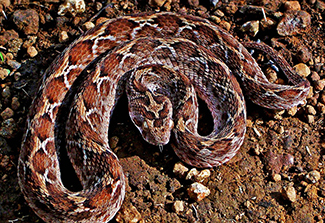Engineering a new molecule to neutralize venoms
September / October 2022 | Volume 21 Number 5
Photographed by Shantanu Kuveskar Dr. Komives' “rejiggered” molecule neutralizes venom from the saw-scaled viper (pictured). The snake is found north of the Equator across Africa, Arabia, and southwestern Asia to India and Sri Lanka.
Dr. Komives' “rejiggered” molecule neutralizes venom from the saw-scaled viper (pictured). The snake is found north of the Equator across Africa, Arabia, and southwestern Asia to India and Sri Lanka.
By Susan Scutti
Claire Komives, a professor of chemical engineering at San Jose State University, California, also works to modernize antivenom, yet her approach is unlike that of
Constantinos Kurt Wibmer. She entered this field after reading a news article around the time she was taking a sabbatical year at the Indian Institute of Technology, Delhi. The article falsely claimed that a particular opossum peptide could neutralize venom from several different snakes. “The data was terrible, still it got me thinking.” After all, she knew that when an American rattlesnake bites an opossum, the animal simply licks its wounds and moves on.
“Just for the heck of it, I purchased some synthesized opossum peptide and sent it to the National Natural Toxins Research Center at Texas A&M University in Kingsville, and they tested it and found that it indeed neutralized a lethal dose of rattlesnake venom.”
Excited, Komives began to compose her wish list for a next generation antivenom: heat resistant, shelf stable, availble as a either pill, liquid, or inhalable mist, and, of course, “super inexpensive."
Working with India and Nigeria
India is thought to have the highest loss of life due to snakebites in the world. A
2020 study estimated 58,00 deaths each year in the country. Komives estimates that areas of Nigeria likely “have equal snakebite prevalence as India," while the
WHO recorded 6,687 people treated for snakebite envenoming in a single Nigerian hospital over a three-year period. Her research has led her to work in both countries.
The team on her project in India, funded by the National Institute of Biomedical Imaging and Bioengineering, ran experiments "to determine whether the peptide, in its native form, could actually serve as an antivenom—meaning you inject it and it'll work.” The tests showed the molecule, in itself, did not work as antivenom, yet she had gained knowledge about its characteristics, including how it binds to other molecules. Seeing an active site, Komives decided to “try to display the peptide the way the serum protein in the opossum does.” She attached the peptide to a camelid nanobody, a technique increasingly used in pharmacology, and now it can be expressed in
E. coli.
Her rejiggered molecule works to neutralize venom “for almost all the Nigerian snakes and one Indian snake, the saw-scaled viper,” said Komives. Currently, she is working on creating a process to produce an active protein that scales in
E. coli. “If it’s successful, then we're talking about having a cheap, single molecule antivenom" that could undergo robust "lot by lot quality control,” she said.
Komives’s progress, like Wibmer's, has been delayed by world events. "During the pandemic we weren't allowed to come to the lab, and then it took six months to get a certain part for my bioreactor." Yet her efforts to design an antivenom continue.
Komives is currently working with the Ministry of Health in Nigeria to do "preliminary safety and efficacy tests, which would be the next step to making the peptide commercialize-able.” Her project has also found support in India, where current manufacturing methods (that use horses) are seen as unethical. "The Nigerian hospital I'm working with sees 3,000 snakebite patients each year, mostly in the rainy season,” she said. Yet, the antivenoms available there are insufficient and cost $100 a dose. “These rural farmers in Nigeria, they simply don’t have the money. They are destroyed financially if somebody in the family gets bit.”
More Information
Updated October 17, 2022
To view Adobe PDF files,
download current, free accessible plug-ins from Adobe's website.
Related World Regions / Countries
Related Global Health Research Topics